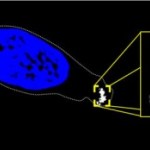iron
Magnetite in a fish nasal cell. Image: The Scientist from Herve Cadiou, University of Cambridge
In a prior blog, we talked about different animals that are able to sense the Earth's magnetic field. The mystery of how fish, and perhaps other animals, do this may be solved. Animals use the magnetic field like a compass. This is an important skill especially to migratory species who don't have the benefit of Google Maps. It is sort of a built-in GPS system.
Dr. Michael Walker from the University of Auckland discovered that brain cells connected to the nasal cavity of fish can be stimulated by…
The Not Exactly Pocket Science experiment continues after the vast majority of people who commented liked the pilot post. I'm really enjoying this, for quite unexpected reasons. It's forcing me to flex writing muscles that usually don't get much of a workout. Writing short pieces means being far more economical with language and detail than usual. It means packing in as much information as possible while still keeping things readable. And it means blitz-reading papers and writing quickly without losing any accuracy.
One quick note before the good stuff: last time, a few people suggested that…
Say the word iceberg, and most people are likely to free-associate it with 'Titanic'. Thanks to James Cameron (and, well, history too), the iceberg now has a reputation as an cold murderous force of nature, sinking both ships and Leonardo DiCaprio. But a new study shows that icebergs are not harbingers of death but hotspots of life.
In the late 1980s, about 200,000 icebergs roamed across the Southern Ocean. They range in size from puny 'growlers', less than a metre long, to massive blocks of ice, larger than some small countries.
They may be inert frozen lumps, but icebergs are secretly in…
Antarctica normally conjures images of white and blue, but the frozen continent can sometimes bear more unexpected colours. Take the Taylor Glacier - when geologist Griffith Taylor first explored it a century ago, he found a bizarre reddish stain that seemed to spill waterfall-like from the glacier's snout. The area became evocatively known as Blood Falls.
The source of the blood-red colour is an underground saltwater lake that was trapped by the encroaching glacier at least 1.5 million years ago. The temperature of the water is -5 Celsius, but it's so salty that it doesn't freeze. It's…
What's going to happen to all the stars in the Universe as they get older? Well, just as nothing can live forever, stars can't live forever also. Why? Because they run on fuel: burning hydrogen into helium, for example. When they run out of fuel, something's gotta give. Barbara Ryden reminds us of an excellent and appropriate quote by Dylan Thomas:
Do not go gentle into that good night.
Rage, rage against the dying of the light.
But what exactly happens to the star depends very sensitively on what the mass of the star is.
If you've got a tiny little star, less than about 40% of the mass of…

